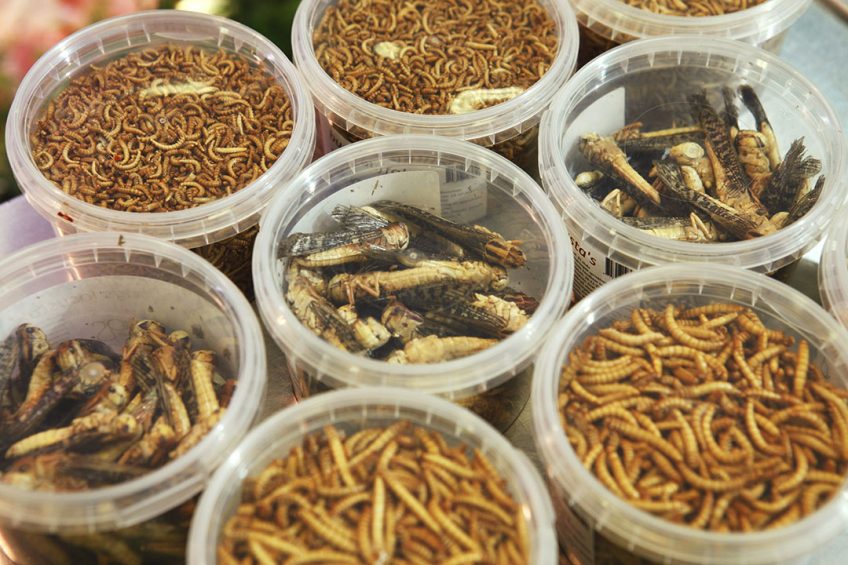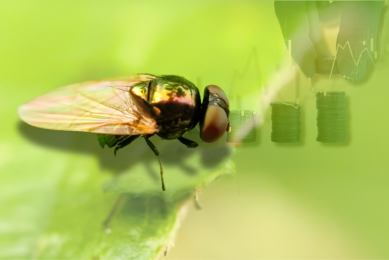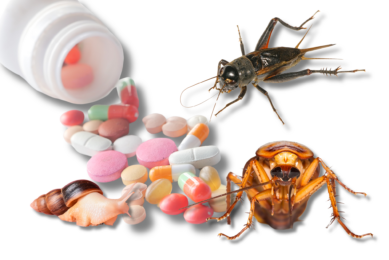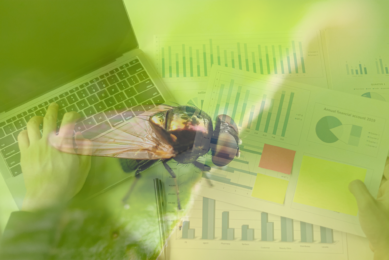The Green Deal and the future of insect feed

The International Platform of Insects for Food and Feed (IPIFF) responses to the effect of the Green Deal on the future of insects in feed.
The European Union’s Green Deal will affect farming and livestock feed in significant ways. In a recent article in All About Feed, we asked FEFAC, Alltech and IPIFF for their perspectives. In this article we further outline the full set of IPIFF responses, provided by Constantin Muraru (Communication Manager), Alice Grassi (Communication Advisor) and Christophe Derrien (Secretary-General) on behalf of IPIFF.
In the EU, insects are ‘farmed animals.’ What are they fed?
Insects are fed a mix of by- and co-products from the agri-food industries and with resources which are currently not being used and not or no longer destined for human consumption, such as the so-called ‘former foodstuff’. The above-mentioned by-/co-products may also include those derived from grains, starch, fruit and vegetable supply chains (e.g. bran, distillers grains, unsold fruit and vegetables, including peels) as well as products arising from the food manufacturing process (other than final products). Among the most frequently used former foodstuffs used in insect farming, we can highlight unused outputs from local food producers, such as bakery products, or products from supermarkets which are unsold due to technical or logistical reasons.
We expect that this ‘green light’ from the European Commission will bring regulatory clarity, encouraging investment into the insect sector and implicitly contributing to its upscaling.”
How much does this vary and why, across the EU?
Insect farms adapt the recipe of the insect substrate considering the suitable products which are available locally. The objective is to provide a complete diet which takes into account the biological needs of the insect species farmed and their life stage – in order to develop food and feed products of predictable/constant quality. However, the ‘recipe’ of the insect substrate may vary depending on the availability of local inputs.
Is what insects are fed changing, or is it expected to change much, and if so, how?
The European insect sector is committed to making a bolder contribution to EU’s target which aims at halving food waste by 2030 (e.g. in line with the ‘Farm to Fork’ strategy and the UN SDG 12.3). To this end, one of the primary objectives is to facilitate food waste avoidance – by redirecting products intended for human consumption (which would not have other use and would otherwise be discarded) to insect farms. From a regulatory point of view, one necessary step is the authorisation of former foodstuffs containing meat and fish (e.g. non-vegetarian pizza, hot dogs, etc.). On this subject, IPIFF is collaborating with the European Commission in order to diversify the list of permitted substrates for insect farming activities.
How soon will you be able to expand production of insect protein as a feed ingredient from aquaculture species to pigs and poultry?
Presently, insect processed animal proteins (PAPs) are authorised in aquaculture feed and pet food. Following the partial uplift of the ‘feed ban rules’ in 2017 (i.e. the ‘aquafeed authorisation’), the European Commission (EC) committed to prioritising its future reforms by authorising the use of insect PAPs in poultry and pig feed. As indicated by Ms Sabine Juelicher (Director for food and feed safety at DG SANTE, European Commission) in the latest workshop organised by IPIFF, the European Commission services ‘are currently working very intensively with Member States for the authorisation of insect PAPs for poultry feed and pig feed’. This regulatory development should take place in 2021, she indicated: ‘I personally see 2021 as a year for a lot of development’.
We expect that this ‘green light’ from the European Commission will bring regulatory clarity, encouraging investment into the insect sector and implicitly contributing to its upscaling. With farms being presently built all across the continent, it would take a couple of years until they will reach their maximum production capacity – delivering high-quality feed ingredients for the aquaculture sector – but also for the poultry and pig feed markets. Future legislative developments (e.g. authorisation of new substrates, development of organic standards for insect farming) would considerably contribute to increasing demand for insects and their derived products.
IPIFF believes that recognition of ‘insect farming’ under the CAP strategic plans would be beneficial for the success of the future policy.”
What will be the main challenges?
Building new infrastructure requires time. We noticed that the Covid pandemic was an opportunity for actors involved in food production and farming to reassess the way the food supply chains function – and now there is growing interest in local solutions, which provide sustainably produced feed and food – strengthening regional resilience.
Guaranteeing feed and food safety is a key priority for our sector. To this end, IPIFF members follow good farming and manufacturing practices in insect farming, as presented in the draft IPIFF Guide on Good Hygiene Practices. This Guide will be soon resubmitted to the European Commission and we expect that it will be validated as the first EU-wide Guide for insect farming activities – providing knowledge and support to both start-ups and established businesses. Considering the status of EU farmed insects (i.e. insects are ‘farmed animals’), at this stage, insects can only be fed with eligible feed materials. In the future, it is likely that new substrates could be authorised for insect farming activities – such as the former foodstuffs containing meat and fish. Following good hygiene practices would ensure that insect-derived products farmed on substrates containing meat and fish would pose no risk for animal or human health.
How will these challenges be overcome?
From an IPIFF perspective, we recommended that insect business operators implement robust traceability and segregation measures. ‘Fully reliable’ analytical methods – in line with the recommendation of the EU Reference Laboratory – must be in place in order to avoid the presence of possible ruminant residues, as well as the prohibition of intraspecies recycling (cannibalism).
How are you making sure that insect farming activities “receive equal attention” under the Common Agricultural Policy (CAP) strategic plans?
For its potential to provide local solutions to farmers’ needs, while also contributing to agricultural diversification, IPIFF believes that recognition of ‘insect farming’ under the CAP strategic plans would be beneficial for the success of the future policy. It is our view that ‘agri-environmental measures should be established in the framework of national rural development programmes to support farmers who decide to diversify their activities by developing insect production systems’ (IPIFF’s Regulatory Brochure).
From the IPIFF position paper The contribution of the European insect sector to improving sustainability from ‘Farm to Fork’: “According to IPIFF members, up to a third of the food waste generated today could be suitable for insect farming – before it is classified as ‘waste’. Why is it not more? What materials are unsuitable for insect farming?
Being farmed animals, insects can only be fed with ‘eligible feed materials’. While presently agri-food co-/by-products from the agri-food chains and former foodstuffs of vegetal origin represent the most significant share of inputs used in insect farming (e.g. see question 1), we expect that the spectrum of authorised substrates would be more diverse in the near future. According to our members’ estimations, up to a third of the food waste generated today may be used in insect farming – either for the food and feed chains (e.g. former foodstuffs containing meat and fish), or for technical applications (e.g. catering waste for non-food and non-feed chains – to be used in bio-based applications).
The possibilities to reduce food waste are diverse – while insect producers target locally available inputs, which are compatible with their farmed species, other types of food waste may be better upcycled through other channels. IPIFF encourages food waste reduction strategies through a concerted approach. A considerable share of food waste may be avoided through ‘prevention’ and ‘optimisation’ – while other products may be fed directly to animals (e.g. former foodstuffs which may be suitable for aquaculture or livestock animals).
Complementary, certain categories of food waste – such as household waste – may be unsuitable since they are, in fact, part of a more diverse mix of waste materials (e.g. packaging material, food contact material, other general household waste).
Last but not least, while different categories of food waste may be biologically compatible with insects – from a life cycle perspective, other possibilities mentioned in the food waste hierarchy pyramid may be more sustainable and economically sound.
How much will the European insect sector ultimately improve the “EU’s self-sufficiency in terms of feed materials”?
According to the EU+UK Protein Balance sheet published by the European Commission in June 2020, the total percentage of EU origin protein feed is 78%. However, for specific types of feed materials, such as the category ‘High-Pro materials’ (30-50% protein content) – this figure is a bit lower: 26% of these protein feed ingredients originate in the EU. In line with the growing demand for EU produced feed, insect production may increase the share of EU High-Pro and Super-Pro (>50% protein content). With the contribution of European insect farming, the present self-sufficiency of High-Pro and Super-Pro feed materials may increase by several million tonnes by the end of the decade.
In the position paper, you state that “Insect farmers implement practices that are consistent with the principles of organic farming”. Will the development of organic standards be a matter of certifying that the insects are fed organic food waste, or are there other factors?
In line with the increasing demand for locally and sustainably produced food, IPIFF members consider that the future organic certification of insect farming activities ‘will allow the sector to maximise its contribution towards a more sustainable food-producing system’. Such a regulatory development would also be aligned with the EU Farm to Fork strategy, which aims at supporting the development of organic aquaculture and agriculture. While these standards are presently developed by the European Commission services – their advancement depends on the ‘horizontal legislation’ (e.g. authorisation of insect PAPs in poultry and pig feed).
IPIFF expressed its support for the development of solid and reliable organic certification standards for insect farming activities – which would also take into account the specificities of insect farming. In addition, IPIFF believes that such organic standards should also reflect current market realities. For livestock farming, sourcing organically certified feedstocks is a major challenge for certified or in-conversion farms. Similarly, sourcing organically certified substrates suitable for insect farming may become a major bottleneck for the sector, since such inputs would not be available in sufficient quantities.
Also from the position paper: “Insect frass can play an important role its capacity to store carbon. IPIFF calls for the immediate adoption of a level-playing field for insect frass application.” Please tell me about carbon storage in insect frass and what do you mean by level playing field and achieve that?
The potential of insect frass as fertilising product in agriculture has been confirmed by numerous trials, as well as research papers. Notably, this by-product from insect farming activities includes a wide range of nutrients ‘in readily-available form’ (Houben et al., 2020) that are necessary for plant development – as well as for plant and soil health. In addition to its minerals (NPK), most of the frass consists of organic matter – which is essential for improving soil fertility and its ability to store carbon. Considering the growing demand for locally produced fertilising products, IPIFF believes that insect frass will play a constructive role in maintaining and improving the EU soils’ fertility. While studies on the promising potential of frass are ongoing (e.g. role in improving plant health and reduce the use of plant protection products), crop farmers from all over the continent start using it in synergy with other mineral or organic fertilising products.
However, while the application of insect frass on agricultural land is economically and environmentally viable – its status under national legislation remained unclear (i.e. there was no EU legislation defining insect frass). Discussions around a Commission Regulation which will facilitate the establishment of a level playing field for insect frass application are at a final stage.











